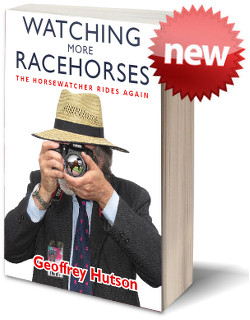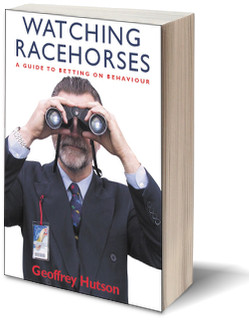 *** NEW ***
*** NEW ***
In Watching More Racehorses, Dr Geoffrey Hutson takes his quest for the Holy Grail of punting – picking winners based on looks in the mounting yard – to a new and higher level. Observations on over 50 new variables and a database of over 50,000 horses show that horsewatchers attending at the track enjoy a considerable and profitable advantage! Geoffrey also explores some of the issues confronting an ageing and serious fun punter, including health and wealth, coping with the unlikely contingency of monetary loss, the intelligence of horses, the lessons learnt from laying losers on Betfair, and the ultimate problem for successful punters, the taxation of gambling winnings!
Order Watching More Racehorses here!
 *** STILL AVAILABLE ***
*** STILL AVAILABLE ***
Dr Geoffrey Hutson’s breakthrough book Watching Racehorses expands upon his original discovery, first reported in New Scientist magazine, that pre-race horse behaviour is a significant predictor of performance.
It introduces the new and unique concept of behavioural handicapping: scoring horses according to how they act before a race. By avoiding or laying those with poor behaviour, punters and horseplayers can gain a deeper understanding of why horses run as they do and improve their strike rate.
Watching Racehorses explains:
- how to assess fatness and fitness – the body condition of horses
- what to look for in the birdcage stalls, including pawing, weaving and restless behaviour
- the impact of horse tack and equipment, including the bridle and bit, tongue tie, nose roll, pacifiers, boots and bandages
- the meaning of sexual behaviour
- what to watch for in the parade ring and mounting yard, including strapper control, horse posture and gait
- behaviour on the track, including sweating and control by the clerk of the course
The book describes over 60 behaviour patterns in detail, including a statistical analysis of the effect each has on a horse’s winning chance. This data, based on careful observation of more than 10,000 horses, is unprecedented in the history of horse racing.
Most racegoers say that they would like to look at the horses, but don’t know where to look. This book shows where and how. There are 250 pages, with over 50 photographs, 30 figures and tables, and a comprehensive index and further reading list.
Written in Dr. Geoffrey Hutson’s inimitable style, Watching Racehorses is a clear, precise and highly entertaining guide to why good horses sometimes run bad.
Order Watching Racehorses here!
Table of Contents
Introduction
Gives a brief and broad outline of the direction of the book. Geoffrey confesses to being a punter, describes his progression through the Seven Ages of Punting Man, his training in animal behaviour, his first study of horse behaviour at the races, and his coming of age as a horse watcher.
Chapter 1. A day at the races
Describes a typical day at the races for a horse watcher, race by race.
Chapter 2. A little looksee
Describes the initial scientific study of pre-race behaviour done by Geoffrey with his student, Marie Haskell. This chapter describes the main variables recorded, including horse fatness, fitness, and coat condition.
Chapter 3. Eureka!
Describes the results of the looksee study.
Chapter 4. Fifteen minutes of fame
Describes the media feeding frenzy that followed publication of the results of the looksee study in New Scientist magazine.
Chapter 5. Picking losers
Discusses the main reasons put forward for horses losing.
Chapter 6. Back to the birdcage
Describes what Geoffrey now looks at in the birdcage stalls, in some detail. This chapter, together with chapters 7-10, is the guts of the book. It includes pawing, weaving, and restless behaviour.
Chapter 7. Perving in the parade ring
Describes responses of the horse to tack and equipment, including the bridle and bit, tongue tie, pacifiers, boots and bandages.
Chapter 8. Did someone say sex?
Discusses sexual behaviour of horses.
Chapter 9. Mounting yard misbehaviour
Describes strapper behaviour, horse posture and gait.
Chapter 10. They’re on the track!
Discusses sweating and control by the clerk, among others.
Chapter 11. 60 variables and 10,059 horses
Describes the results of an analysis of 60 of the 65 variables described in Chapters 6 to 10 and how they can be used to pick losing horses. This is the first time that actual statistics (percentages) on the likely success or failure of horses showing particular behaviours have been published.
Chapter 12. Betting on behaviour
Proposes a few ideas for betting on the results of horse watching, including betting for the win, making a Dutch book and betting for the place.
Chapter 13. Which horse, which race?
Discusses favourable types of race for betting.
Chapter 14. The Melbourne Cup
Describes some of the practical difficulties of applying horse-watching techniques to the Melbourne Cup.
Further reading
Provides a comprehensive reading list of all relevant references.

